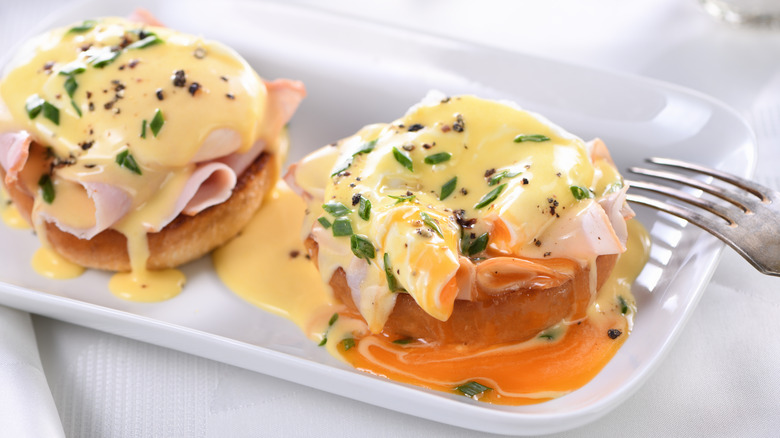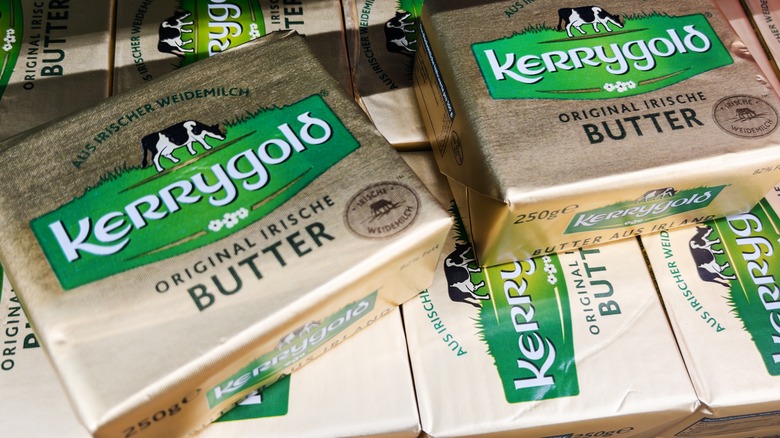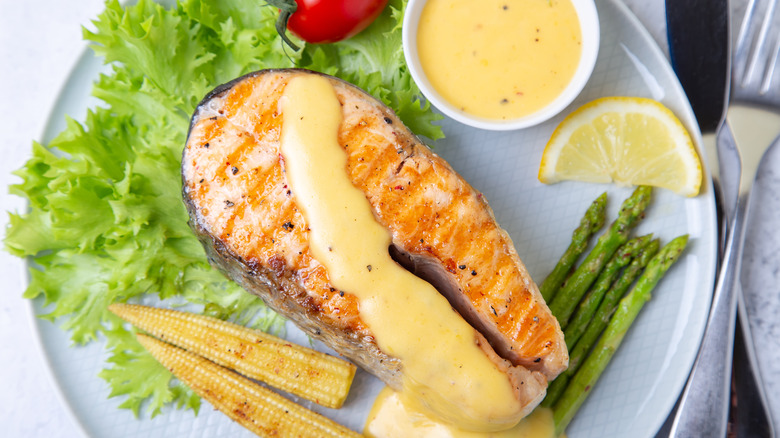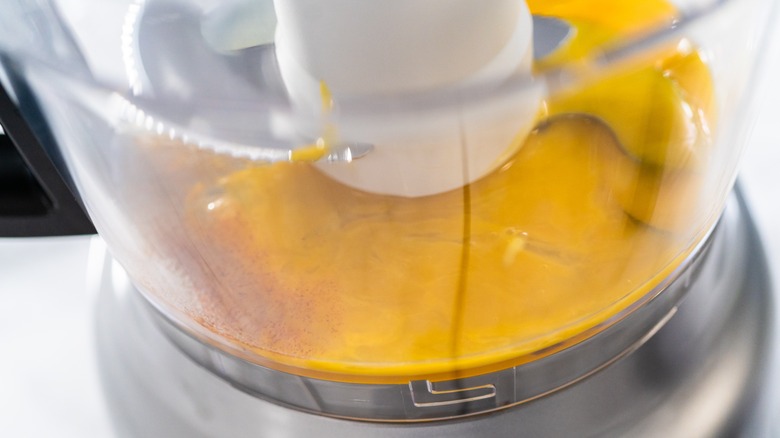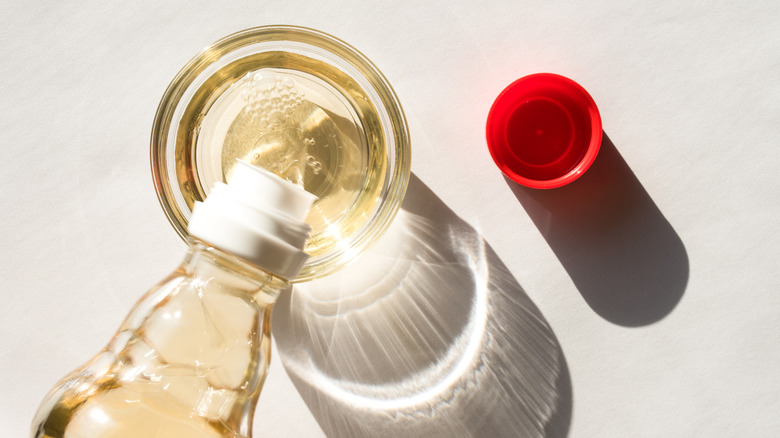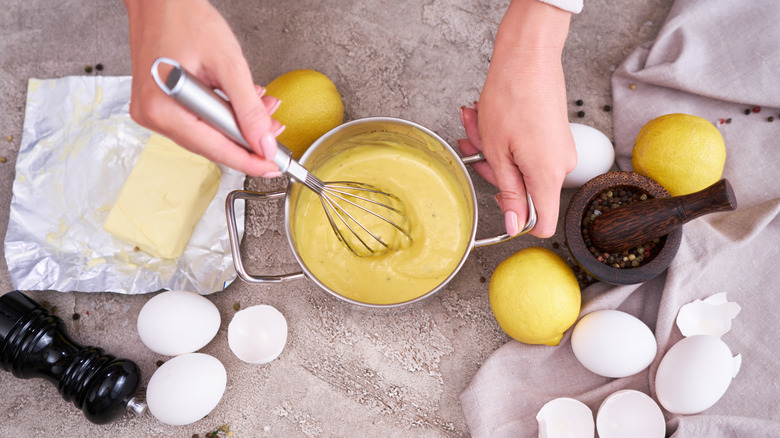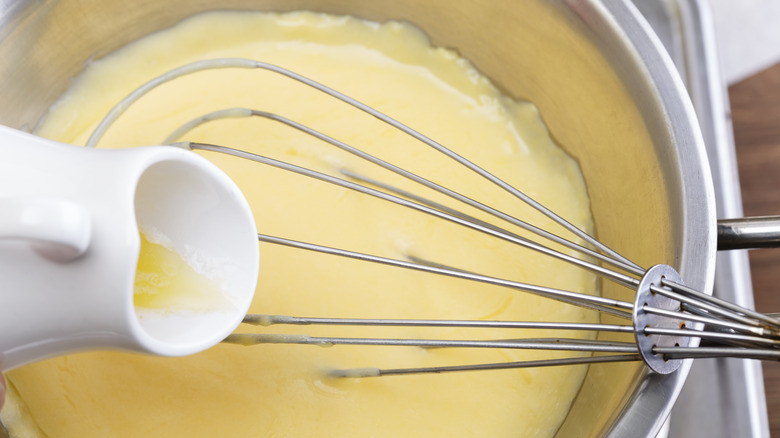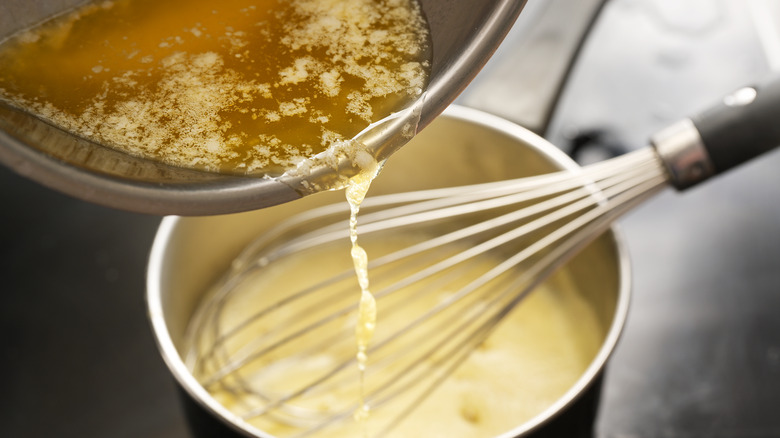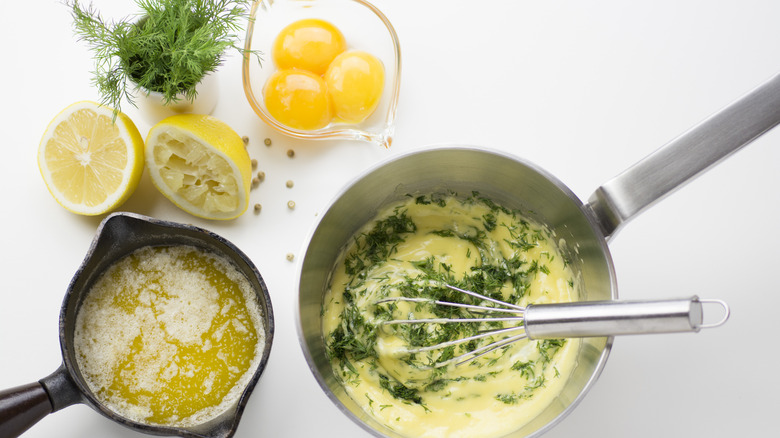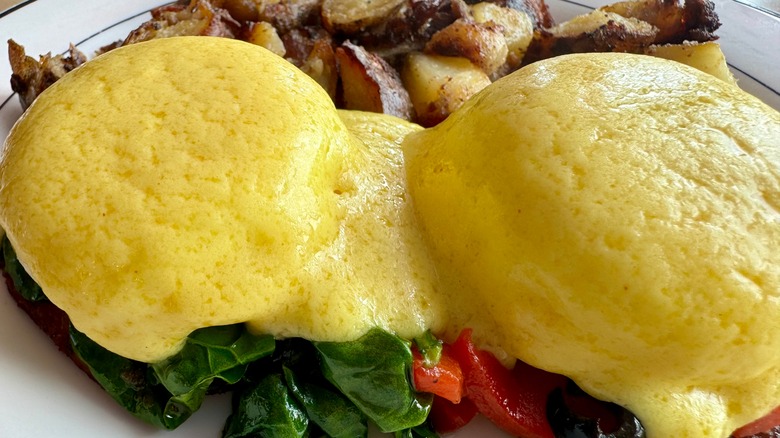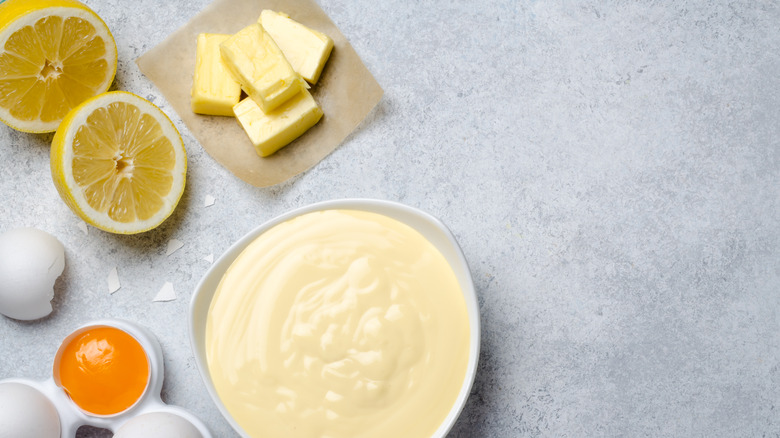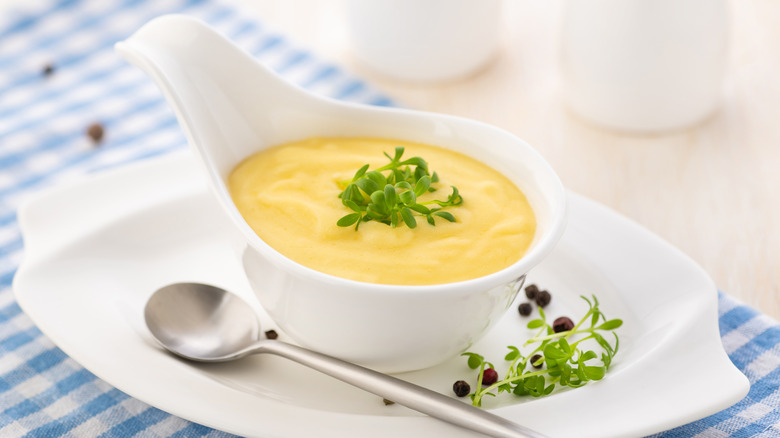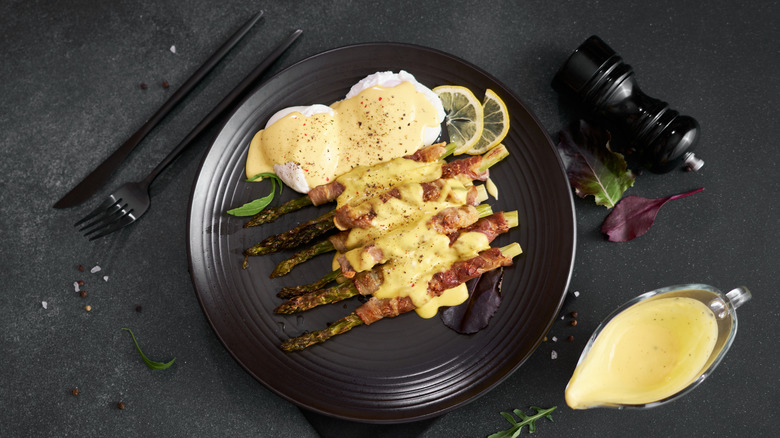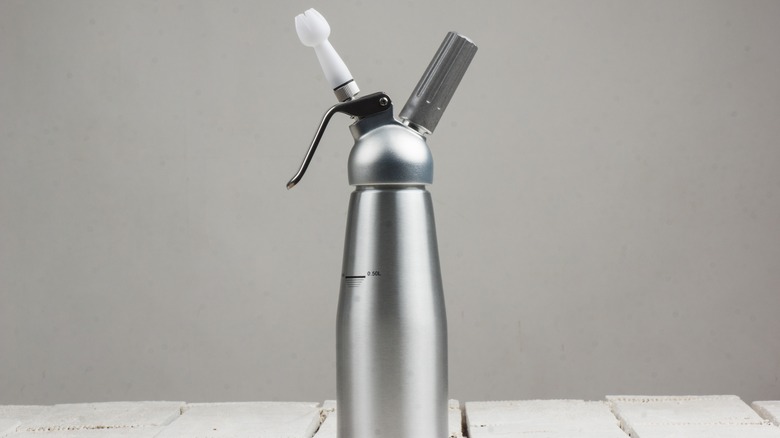Experts Explain The Big Mistakes That Are Ruining Your Homemade Hollandaise Sauce
What's not to like about a light, succulent butter sauce? When you're talking about hollandaise, there's very little to scorn. When made correctly, it elevates ho-hum asparagus or poached salmon into something much more than the sum of its parts, adding a punch of acidity and a velvety richness to each bite. And in the case of dishes like eggs Benedict, they're not complete without a healthy ladle of the creamy yellow sauce poured over the top.
Hollandaise is one of five classic mother sauces, and if you're trying to elevate your kitchen skills, making hollandaise from scratch should be on your bucket list. The sauce is an emulsion, which is when a fat (such as butter) and a liquid (like water, egg yolks, or a reduction) don't want to join forces, but are whipped into a creamy, fluffy combination that creates culinary magic.
While the ingredients for hollandaise are relatively simple, the technique for creating a perfect version can take some practice. If you've ever had hollandaise that's too thick or lumpy when the eggs and butter separate (referred to as the sauce "breaking"), you're in sad, but common company with a lot of us. To prevent some common hollandaise mistakes, we spoke with culinary experts about how to create the best possible sauce, every time. Here are some of the common mistakes they shared, along with how to fix them.
1. Buying low-quality ingredients
At its most basic level, hollandaise is made with egg yolks, butter, and a little bit of water, plus salt and lemon juice for seasoning at the end. It's a very short grocery list, and you might even have all of them in your kitchen already. Technically speaking, the quality of your ingredients won't matter when it comes to the chemistry of cooking a hollandaise, said Shawn Matijevich, the lead chef-instructor of online culinary arts & food operations at the Institute of Culinary Education. If you pull eggs and butter from your refrigerator, they can make a hollandaise.
However, Matijevich was also quick to note that anyone who spends a lot of time in a kitchen realizes the quality of ingredients matters, especially when your dish doesn't have many components. "When it's only a few ingredients there's not a lot of opportunity to hide bad-quality ingredients, or mediocre-quality ingredients," he said. "It makes a big difference in the overall product. There's nothing to hide."
In the case of hollandaise, Matijevich said he chooses pasteurized eggs (which are still raw but treated to kill pathogens like salmonella) and grass-fed butter. His personal favorite brand is Kerrygold, which happens to be our top-ranked butter at Mashed, too. If you're aiming to elevate your at-home brunch, start with ingredients you might splurge on.
2. Following a written hollandaise recipe too closely
Cooking is about ratios. Normally, written recipes help us get those ratios correct the first time, but in some cases, they can be a stumbling block. Shawn Matijevich says cooking hollandaise sauce is one time when you should hold the recipe loosely.
"One of the problems that a lot of people also have with recipes is that they follow them a little too closely," he said. He went on to explain: The technique you use to create the sauce will determine how much butter you should add to your egg yolks. Generally, you'll want to warm 2 to 3 ounces of butter for every egg yolk you're cooking with. The eggs and any water you add supply the liquid for the emulsion, and the fat from the butter is what combines into a creamy sauce at the end. Depending on the amount of liquid and how well it combines with the butter, you might need every drop of that butter — or have a little left over.
If going off-book for making hollandaise makes you nervous, don't fret. We'd suggest using a basic hollandaise recipe as a starting point, but then relying on what you're seeing, smelling, and tasting for perfect results. "You've got to use all of your senses when you're making this one," Matijevich said.
3. Using a blender to make the sauce
Using a blender to whip together a hollandaise sauce is a popular hack these days. In fact, the recipe we linked to suggests it, and so do cooks like The Pioneer Woman and others. It saves your arm from whisking for what seems like an eternity, but Shawn Matijevich suggests avoiding it.
"In my opinion, what I like to see is a very light and fluffy and also rich sauce," Matijevich said of hollandaise in general. Blenders will give you an emulsion, there's no doubt about it. However, Matijevich said that blender-made hollandaise sauces tend to be more dense than a classic version, and end up having a consistency that's more like mayonnaise.
Matijevich suggests beginners use the classic double boiler technique, in which you cook the eggs and butter in a bowl over simmering water on the stovetop. "When you're using a double boiler, you wind up with a greater margin for more time to be able to catch something that might be overcooking," he said.
It's possible that even with a double boiler and a whisk, your sauce will get too thick. If that's the case, add ½ teaspoon of warm water to your mixture at a time and whisk in between to loosen it up to your desired consistency, suggests Kyle Mendenhall, the senior director of culinary innovation at Snooze, An A.M. Eatery.
4. Skipping the option to add more flavor to your hollandaise
If your goal is a fancy brunch at home, or a hollandaise to impress even the most critical of guests, use simple techniques to elevate the basic sauce. One way to do this is with a liquid reduction instead of plain water in your recipe.
Plain water will do the trick, but using a reduction is a chance to impart even more flavor using aromatics, whole spices, and acids besides lemon juice. For example, Shawn Matijevich said he'll make a reduction by combining flavored vinegar, water, shallots, and whole peppercorns in a pan, and then cooking it down for several minutes. The strained liquid is much more flavorful than plain water, and can give your hollandaise an extra boost without being overpowering.
If you've never tried making a reduction before, this hollandaise recipe from Gordon Ramsay provides instructions for a basic one. From there, you can customize it for your personal preferences. This is a chance to get creative, even if the rest of the hollandaise-making process is fairly cookie-cutter.
5. Not gathering ingredients before you start cooking
Hollandaise comes together quickly once you actually get started, and not having your ingredients readily at hand can add some pre-brunch stress you don't want. Do yourself a favor and gather the ingredients you need, so the sauce can come together as simply as it's supposed to. (Gathering your pre-measured ingredients before cooking is referred to in French as "mise en place" and is a cooking step that good home cooks use, not to mention professional chefs.)
For a classic hollandaise, you'll separate your egg yolks, and measure out your liquid (either plain water or a reduction.) That should be 1 tablespoon per egg yolk, per Shawn Matijevich. You'll want to measure 3 ounces of unsalted butter per egg yolk next (remember, you might not use all of that, but have it ready in case). That butter should be clarified if you're doing things 100% by the book, which means you heat it and strain the milk solids from it so that all you're left with is a smooth, yellow liquid. The butter should be very hot, both Matijevich and Kyle Mendenhall said: Not so that it's scorching, but hot enough so that it's uncomfortable to touch. Finally, you'll want to gather your seasonings for the end, which at the very least should include salt and fresh lemon juice (more on that later).
6. Not whisking the hollandaise fast enough
If you're taking Shawn Matijevich's advice and using a double boiler, that means you'll also be using a whisk. "I think the whisk is the best way to go for the first time — for the first 20 times — you make it," he said. That said, it's also where the most frequent mistakes come in, he noted.
"The biggest thing is that people just don't whisk it hard enough," Matijevich explained. "They think they're whisking it hard, and I suppose that's a relative thing ... It's all in the wrist, it's not using your arm, it's just flicking your wrist back and forth as fast as you possibly can."
You will probably get your arm workout in for the day making hollandaise. To start, you'll whisk the egg yolks and liquid you're using together in a bowl (off the heat at first) until they are light and frothy. "There's really not a way you can over whip these," Matijevich said. Then, you'll put that mixture on top of the double boiler and continually whisk it. The yolks will get even lighter in color and get frothier with the heat. At 160 degrees Fahrenheit, the eggs won't run back to the center of the bowl as quickly, Matijevich said, which is when they're cooked enough to start accepting the butter properly. That in itself has its own proper technique.
7. Adding butter to the eggs too quickly
Ideally by this point, your eggs are cooking (but not scrambling), and your butter is hot in a separate pan. This is where hollandaise-making can really break down — literally. Liquids and fats don't like to mix, and they'll resist at first. Getting them to combine is the magic of emulsions in general, and hollandaise specifically.
"You're trying to pulverize the fat down into a size where it can't get together with its other fat friends," Shawn Matijevich said. Part of that means whisking like your life depends on it. The other part is adding the butter very slowly at first — we're talking a few drops at a time. As you're whisking it, look at the sauce. If it's looking greasy, like the fat is collecting on top, you need to whisk more thoroughly before adding any more butter. As it starts to incorporate, however, you can start adding the butter in a slow stream. "Once that emulsion starts, it'll continue pretty well on its own," the chef assured us.
8. Not using your senses at the midpoint of cooking the sauce
The sauce takes on a life of its own during the emulsion process, but you'll need to pay attention to know when you've added enough butter. To do this, Shawn Matijevich suggests tasting the sauce for the first time after you've added two ounces of butter per egg yolk into the mixture. Tasting at this point will help you decide if you need to add more butter, or if your sauce is close to being finished.
If your sauce is getting to the point where it's ready to serve, it shouldn't taste "eggy" at all, he noted. You should really only taste butter and whatever seasonings you've put into it up to this point, via the liquid reduction. If it still tastes too much like eggs, or if the sauce is still too thin for your liking, continue adding butter.
Matijevich reminds us that the liquid in hollandaise (egg yolks plus the water or liquid reduction) can only absorb so much fat. There's a saturation point where it'll get too thick, and you might start to see small drops of oil on top. If you see either thing start to happen, stop adding butter. If you ignore those signs, your sauce could split.
9. Throwing the hollandaise out if it splits (it can be saved!)
Nothing is more discouraging when making hollandaise than when you've measured your ingredients and mixed them together, whisking your heart out — only to have them split apart into an unappetizing, oily mess. Both Kyle Mendenhall and Shawn Matijevich say all is not lost, however. "Don't panic!" Mendenhall wrote in an email. "Remove separated butter from [the] yolk base as best as possible and restart the combining process (add another yolk to the base and reheat butter as needed)."
Matijevich suggests going as far as dumping the split sauce into a different bowl and starting with a clean one on top of the double boiler. Add one egg yolk and a tablespoon of hot water. When it's properly heated, begin using your old sauce ingredients to finish it. "Slowly start your emulsion again with your old sauce, just start pouring it in, and it should come back together," Matijevich coached. It's not always the case, but Matijevich said this sauce often breaks when you add too much butter toward the end, so you're unlikely to need more.
10. Forgetting to season at the end with salt, lemon juice, and spices
Once you have a light, fluffy sauce that's (almost) ready to serve, you need to take one last important step: season it with more flavor! Adding salt at the end is Shawn Matijevich's preferred method. That way, you can get the flavor exactly to your liking once variables like egg yolks and butter measurements are out of the way.
Butter by itself is incredibly rich, so adding an acid like lemon juice is also vital. With practice, you'll have your guests raving about your flavor combinations. "Balancing salt and fat and acid: That's just what we do as chefs," Matijevich said. "That's why we're able to have control over your tastebuds."
After the requisite salt and lemon juice, any additional seasonings are icing on the cake. However, incorporating specialty ingredients like Espelette pepper can take your version up a notch, the chef suggested. This pepper, which originates in France, isn't quite as spicy as cayenne pepper (which can be used as a substitute), but has a distinctive red color and unique flavor that set it apart. "If you're a beginner and you want to make it fancy, Espelette pepper is the way to go," Matijevich said. If fancy powdered peppers aren't your thing, a good-quality white pepper can also add some extra flavor your taste buds will appreciate.
11. Letting the sauce get too cool before serving
If you're making hollandaise ahead of when your guests arrive, make sure you have a plan for how to keep the sauce properly warmed — without cooking it further. In a commercial kitchen, Shawn Matijevich said there is never a shortage of warm places to let a hollandaise hang out before service: The top of the oven, under a heat lamp, or in a warmed service station are all options.
In your own kitchen, Matijevich said you're aiming to keep the sauce around 110 degrees Fahrenheit. This will keep it from overcooking, but also warm enough to retain its sauce texture, rather than starting to solidify. You could set it on your stovetop, or create a water bath to set your hollandaise bowl in, with the water between 120 and 130 degrees Fahrenheit, Matijevich suggested.
That said, having the sauce get too cool is generally better than getting too hot — which is when it's more likely to break. If it cools too much, it'll become so thick that it's unpleasant to eat, but it's easily fixable. "You can either heat it up very gently, or if not's too cool, you can add a couple drops of hot water to it, stir it a little bit, and then it's good to go," Matijevich said.
12. Not balancing the amount of sauce with the food on the plate
Is there such a thing as too much butter? Or, in this case, too much hollandaise? The beauty of cooking for yourself at home is that you get to decide how much sauce you actually want on your plate. If you're serving it up for guests informally, perhaps you'll allow them to serve themselves, too.
However, if you're composing plates for your table, keep in mind that there probably can be too much of a good thing. The fattiness of the butter sauce can overwhelm everything else, and take over lighter flavors like eggs or salmon. If eggs Benedict are on the menu, Shawn Matijevich suggests aiming for about 1.5 ounces of sauce.
If you don't feel like measuring that out (and who really has time for that?), once again rely on your senses to determine what looks appropriate. "If I'm putting a sauce on a dish, I should be able to have a bite of it with every bite of food that's on the plate," the chef said as a general rule of thumb.
13. Tossing unused hollandaise
You've gone through all of these steps and created the perfect hollandaise — it would be a shame to have any leftovers go to waste. Shawn Matijevich has a clever trick to avoid this altogether: He heats the hollandaise ingredients to the correct temperatures and then puts all of them into an iSi whipped cream dispenser — just like you'd use for actual whipped cream, or whipped matcha lattes. So long as the ingredients are cooked to the right temperature, Matijevich said you'll get a perfect consistency of hollandaise sauce every time. (And yes, this is one chef-approved way to avoid whisking until your arm falls off.)
This also allows you to reuse the sauce later on, the chef noted. When you're finished with the portions you need, simply put the whipped cream canister into the refrigerator. The next time you want to serve hollandaise, put the canister into a hot water bath to gently reheat the ingredients before serving. Matijevich said if he's making brunch for a crowd, he heats the ingredients the night before, puts them in the canister, and then reheats it for serving the following morning.
One food safety note: According to the USDA, any food above 90 degrees Fahrenheit (hollandaise included) is only safe to have heated and sitting out for under an hour. If you reuse the sauce, make sure it stays within that window.
